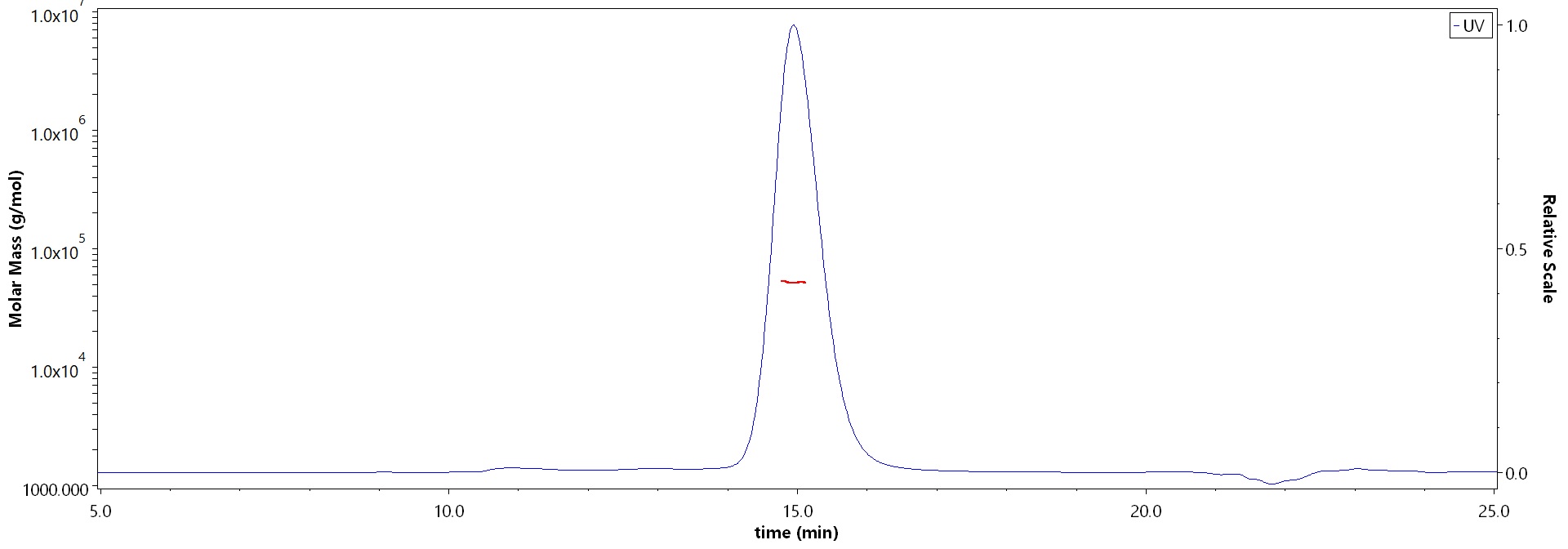分子别名(Synonym)
CD14
表达区间及表达系统(Source)
Human CD14, His Tag (CD4-H5228) is expressed from human 293 cells (HEK293). It contains AA Thr 20 - Met 344 (Accession # AAH10507).
Predicted N-terminus: Thr 20
Request for sequence
蛋白结构(Molecular Characterization)

This protein carries a polyhistidine tag at the C-terminus.
The protein has a calculated MW of 35.9 kDa. The protein migrates as 40-53 kDa under reducing (R) condition (SDS-PAGE) due to glycosylation.
内毒素(Endotoxin)
Less than 1.0 EU per μg by the LAL method.
纯度(Purity)
>98% as determined by SDS-PAGE.
>90% as determined by SEC-MALS.
制剂(Formulation)
Lyophilized from 0.22 μm filtered solution in PBS, pH7.4. Normally trehalose is added as protectant before lyophilization.
Contact us for customized product form or formulation.
重构方法(Reconstitution)
Please see Certificate of Analysis for specific instructions.
For best performance, we strongly recommend you to follow the reconstitution protocol provided in the CoA.
存储(Storage)
For long term storage, the product should be stored at lyophilized state at -20°C or lower.
Please avoid repeated freeze-thaw cycles.
This product is stable after storage at:
- -20°C to -70°C for 12 months in lyophilized state;
- -70°C for 3 months under sterile conditions after reconstitution.
电泳(SDS-PAGE)

Human CD14, His Tag on SDS-PAGE under reducing (R) condition. The gel was stained with Coomassie Blue. The purity of the protein is greater than 98%.
SEC-MALS

The purity of Human CD14, His Tag (Cat. No. CD4-H5228) is more than 90% and the molecular weight of this protein is around 44-58 kDa verified by SEC-MALS.
Report
背景(Background)
Cluster of differentiation 14 (CD14), is a cell surface glycoprotein, and is a is a component of the innate immune system. CD14 is a myelomonocytic differentiation antigen preferentially expressed on monocytes, macrophages, and activated granulocytes. CD14 exists in two forms. Either it is anchored into the membrane by a glycosylphosphatidylinositol tail (mCD14) or it appears in a soluble form (sCD14). Soluble CD14 either appears after shedding of mCD14 (48 kDa) or is directly secreted from intracellular vesicles (56 kDa). CD14 acts as a co-receptor (along with the Toll-like receptor TLR 4 and MD-2) for the detection of bacterial lipopolysaccharide (LPS). CD14 can bind LPS only in the presence of lipopolysaccharide-binding protein (LBP). CD14 has been proposed to be involved in various biological processes, including transportation of other lipids, cell-cell interaction during different immune responses, as well as recognition of apoptotic cells. Although LPS is considered its main ligand, CD14 also recognizes other pathogen-associated molecular patterns. CD14+ cells are monocytes that can differentiate into a host of different cells. CD14 has been shown to interact with Lipopolysaccharide-binding protein.























































 膜杰作
膜杰作 Star Staining
Star Staining













